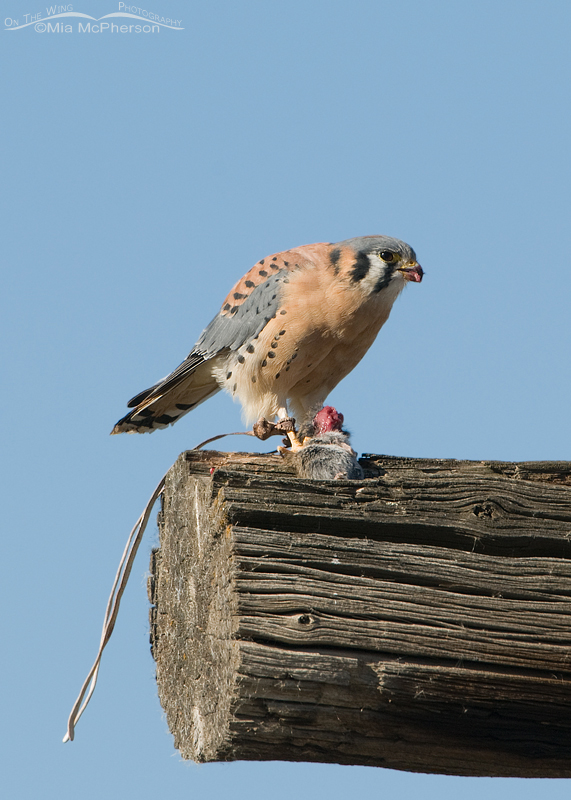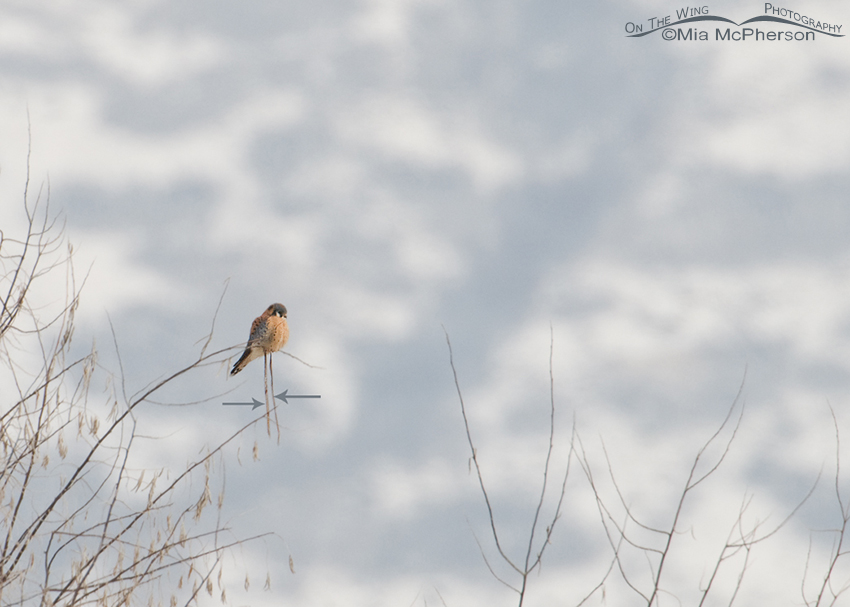On November 3, 2009 I spotted an American Kestrel while leaving Farmington Bay Waterfowl Management Area in Davis County, Utah that had me thinking I was losing my mind because it appeared that there were two long stalks of dried grasses trailing from its legs as it flew by. I didn’t mention it to Ron at the time because… well it sounded a little crazy.
Then on November 5th, 2009 I spotted a kestrel perched on a telephone pole in the same general area and could see that it had light-colored jesses attached to its legs. I could not get photos of it at the time because my camera was belted into the back seat but there was NO mistaking the jesses for grass stalks that day.
I reported the escaped American Kestrel to the Utah DWR along with directions to its location. The Utah DWR oversees falconry permits, federal rules and regulation regarding falconry , falconry permit applications, falconry raptor capture guidelines and it is the office to contact regarding escaped falconry birds.
 Male American Kestrel, escaped Falconry bird with jesses attached
Male American Kestrel, escaped Falconry bird with jesses attached
Over the course of several weeks I saw the escaped American Kestrel often and was pleased when I saw it with prey. In dealing with the manager of the Great Salt Lake Nature Center; Justina, and the DWR and local Falconers trying to recapture the bird I called him Jack to make it simpler than saying “the escaped American Kestrel”. Jack became a familiar sight in the area where I first spotted him.
 Male American Kestrel with jesses attached
Male American Kestrel with jesses attached
I was concerned about Jack because the trailing jesses could easily have become entangled on branches, twigs, power lines and more. In the image above Jack was perched on a Russian Olive tree, the gray arrows point to his jesses. I think it is easy to see how the jesses may have gotten tangled putting his life at risk.
Because of inclement weather and not being able to locate him Jack wasn’t recaptured by his owner until December 12, 2009. The owner brought him by so we could see him up close, I had begun to feel attached to Jack (his owner called him Orion) during the weeks before his capture and was glad to see him so close.
A few weeks later I spotted a kestrel in the same location with jesses on again. A Sharp-shinned Hawk had dive bombed and chased Jack while the owner had him outside and he escaped again. The reason he kept coming back to that specific location was because that was the area where Jack had first been captured to become a falconry bird. The owner decided to allow Jack/Orion to become a free bird again. I saw him a few times after that, once when he only had one jess remaining. After that I only saw male kestrels in that area without jesses. I was glad he was free once more. To this day when I see a male American Kestrel in that location I wonder if it is Jack.
 Peregrine Falcon – Escaped Falconry Bird – sighted September 17, 2012
Peregrine Falcon – Escaped Falconry Bird – sighted September 17, 2012
Let’s fast forward now to September 17, 2012. My mom was with us as we headed to Antelope Island State Park and I spotted a falcon flying along the causeway to Antelope Island State Park. When it stopped I could see it on prey on the muddy shoreline and when I got my lens trained on it I realized the Peregrine Falcon had anklets with grommets on it for jesses to be pulled through. The light wasn’t very good and my images were terrible.
I used my SmartPhone to search for the phone number to the DWR and called them to report the Peregrine Falcon as an escaped bird and gave them the last location where I had seen it. That was the last time I heard from the DWR about this escaped Falcon. With Jack they were in touch with us letting us know what was being done for him, I am disappointed that the DWR didn’t follow through with letting me know what was going on with this Peregrine.
 Peregrine Falcon – Escaped Falconry Bird – sighted October 14, 2012
Peregrine Falcon – Escaped Falconry Bird – sighted October 14, 2012
Two days ago while on the causeway to Antelope Island I sighted a bird zooming past and knew it was a falcon from its speed, shape and the way it flew. While I kept my eye on the bird Ron turned the pickup around and I could tell the approximate location where the bird landed. As we came up on that location I saw two birds, one smaller than the other and very quickly the smaller bird took off, it was a Prairie Falcon, the larger remaining bird was a Peregrine Falcon on prey. The light wasn’t optimal for photographing it but I did any way and within the first few frames I realized the bird had anklets on. It was the same general location as the escaped bird I saw on the 17th of September and the anklets with the grommets appeared identical. I’m almost certain (99.99%) it was the same bird as the month before.
There haven’t been any bad snow storms like there were when trying to recapture Jack the American Kestrel which made it difficult for the Falconers recapture efforts and without the DWR contacting me I just don’t know if the owner of this falcon has decided to allow it to become a free bird again. It worries me though because of the anklets, they aren’t likely to get entangled with something like jesses could but they still could cause problems.
 Escaped Falconry Bird – Peregrine Falcon – sighted October 14, 2012
Escaped Falconry Bird – Peregrine Falcon – sighted October 14, 2012
This Peregrine Falcon ate what appeared to be either a Lesser or Greater Yellowlegs (from the legs & feet I could see). It kept looking over at us and vocalizing when it wasn’t eating, I’m not sure why, perhaps a falconer could explain that behavior.
I know that falconry birds and rehabbed raptors can be used as excellent tools in educating the public, I’ve been impressed with them myself. But there is a risk for falconry birds that escape and that still have jesses or anklets attached and that fact worries me. I know if this were my bird I wouldn’t be able to rest until the anklets were gone.
At this point with this falcon being free for nearly over a month since I first spotted it my hope is that the Peregrine will remove the anklets and resume being a free bird, going where it wants to, when it wants to and doing what comes natural to it.
Fly free & wild Peregrine.
Mia


Mia, what a sensitive and beautiful post. It really touched me to think about these various birds and the hazards posed by their jesses. As many things as I consider in terms of wildlife dangers, I admit, I didn’t realize how often falconry birds get away with these potential entanglements on their legs. I will keep that Peregrine in my thoughts in a most positive way.
Ingrid, I am grateful that this falcon didn’t have her jesses attached to the cuffs/anklets otherwise she might be in more danger. But she is catching prey, staying in an area where prey is plentiful and she looks very healthy. Other escaped falconry birds might not be as lucky.
Interesting story in tracking the status of these guys. Being so delicate a machine, I empathize with your concerns over the jesses and entanglement etc, I react that way too. It is hard to determine I think, how much discomfort or effect they are having on the bird. Thanks for posting Mia.. and great images also.
Thanks Stu, I think this falcon will be ok.
Well put Mia, excellent photos.
Thank you very much Bob!
I feel so bad for the escaped falconry birds. They have those straps on their feet and it makes me feel as if they could get caught on something.
Maria, she should be ok since the jesses weren’t attached to the anklets. And she is eating well.
Mia, how alarming! Is there no one else to call? Maybe the new media would be interested in the story and it would put pressure on the DWR! I hate to think of the bird becoming entangled yet I am glad that it is free! Would your local Audubon chapter be of any help?
Kathie,
I’ve learned a lot about falconry through this and I think this female Peregrine is going to be fine. Both times I have seen her she has had prey and she is very healthy looking. Her anklets/cuffs won’t be as much a problem for her since the jesses weren’t attached. She is staying in an area where there is plentiful food too.
Hi ~ Really enjoyed this story and was glad for the happy ending. And your photos were fantastic. The Kestrel is one of my favorite species. Keep up the great work on your site and your photography work is superb!
Take care.
Joe
Thanks so much for commenting and visiting my blog Joe. I think I have fantastic subjects.
Love you story here and great follow ups….now that’s dedication. Love the pics again:) I had the same thing going on with a family of Great Horned Owls this past year. It was amazing. Those jesses worry me as well. Hope he’ll be okay.
Thank you Chris. I hope she’ll be ok too.
Hmmm…I’ve not noticed this in the field yet, but you have multiple experience documenting it. I wonder how much of a problem it is and if jesses hamper the birds ability to live a normal life. In your images, they look like they’re doing all right.
Robert, I’m almost sure the Peregrine will be ok, both times I have seen her see had prey so she is hunting well. I also heard that she was spotted while I was away in Nevada last week, in the same general area. Her anklets/cuffs won’t present as much of an issue with safety as it would had her jesses been attached to them.
impressive reportage, good job mia
see you soon ☺
Thank you Eric.